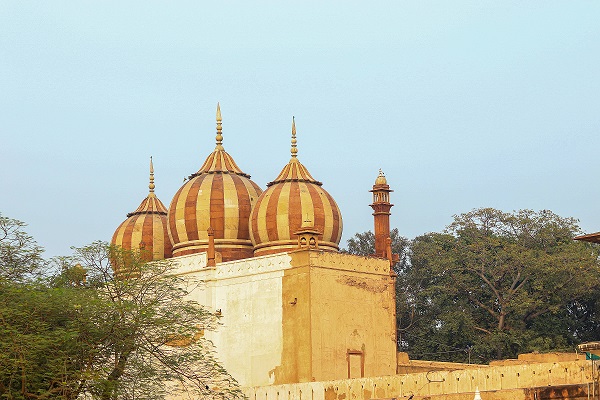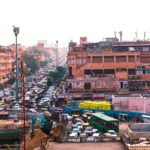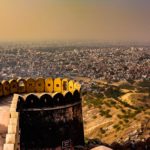The Safdarjung’s mausoleum is considered to be the last flicker of the glory of the Mughal dynasty that makes you wonder about its beauty and the story of its history. It is one of the most beautiful architectural wonders of India’s rich heritage. The entire mausoleum is surrounded by huge palm trees, which adds a new dimension to the beauty of the monument.
If you’re the one who is fed up with their hectic schedule of corporate jobs & want some peace then make sure not to miss the trip to Safdarjung Tomb while visiting Qutub Minar & Red Fort on their trip to Delhi. If you are a traveller and especially a foreigner, you cannot miss this historic building, which reflects the grandeur of the Mughal era.
Safdarjung Tomb Timing:
While the tomb looks stunning after sunset, we wish we could enter the complex but you can visit this ravishing tomb only between 7 am to 5 pm on all seven days of the week.
Safdarjung Tomb Ticket Price:
Also, the entry fees are just 50 Rs & 300 Rs for foreigners. You can also explore this place with your loved ones. Even I have seen many pre-marriage shoots being conducted here.
How to Reach Safdarjung Tomb:
It is located close to Jor Bagh metro station which makes it very awesome. You can also rent an auto for 40 rupees or if you are a traveller you may prefer to go for a 10-minutes walk amongst majestic trees. Delhi is well connected by metro which makes it easier for everyone to reach any place without any hassle.
So, I prefer the metro every time otherwise you can go by cab or bus also, the nearest bus stop is Safdarjung Madrasa bus stop.
Best Time to Visit Safdarjung Tomb:
The best time to visit this place is between November and March when the climate of Delhi is cold and pleasant. I was lucky enough to see it in the morning. If you’re a photography enthusiast like me, then you should visit this place early in the morning to avoid the evening rush.
Safdarjung Tomb Architecture:
The Safdarjung mausoleum complex has a three-domed mosque, an underground chamber and pavilions with the tombs of Safdarjung and his wife. There are majestic gardens, fountains, and a water canal flowing through the complex that is perfect for the delight of photographers who love to capture balanced and architectural photographs.
The planned last monumental tomb garden of the Mughals is made from sandstone & marble. Arabic inscriptions on the walls and carved ceilings further enhance its beauty. The place is not very popular like Humayun’s Tomb, yet many bizarre things make it worth the visit.
At first glance, the entire beautiful structure reminds me of the central dome of the Taj Mahal, a style used in Mughal architecture. The monument has an atmosphere of spaciousness and its domed and reddish-brown and white structures make it unique from other places like the Taj Mahal or Humayun Tomb.
After being out of a busy schedule for a long time, I can say that I felt the peace I needed or wanted to. Also, if you’re not aware of that the famous Hollywood movie “Jobs”, it was shot in this magnificent tomb.
Apart from this, there are also a lot of nearby attractions where you can stop – Lodhi Gardens, Nizamuddin Dargah & Sikandar Lodhi Tomb. If you are a shopping and food lover, you are quite lucky as Khan Market, Mecca of Delhi for brand-conscious shoppers and Moti Mahal Delux, Flavours of Tibet, The Hungry Monkey, are only a stone’s throw respectively.
Who built Safdarjung Tomb?
Safdarjung Tomb also is known as “Safdarjung ka Maqbara”, located in the capital city of Delhi. Safdarjung Tomb was built by Safdarjung’s son Shuja-ud-Daula in 1754 for Nawab Safdarjung.
Safdarjung Tomb History:
Safdarjung is popularly known as Mirza Mukim Abul Mansoor Khan, who ruled Awadh for many years, and migrated to Delhi after the death of Mughal emperor Nasir-ud-din Muhammad Shah. When Mohammad Shah Ahmed Shah ascended the throne of the Mughal Empire in Delhi in 1748, Safdarjung was made the Prime Minister of the empire with the title of Wazir ul-Mamlak-e-Hindustan (Prime Minister of Hindustan). At the time the Prime Minister (Vazir) had all the powers, the king was only a puppet who was fond of liquor, opium and women.
But his control over the emperor’s family was so fiendish that the emperor summoned the Marathas to get rid of it. The Marathas drove Safdarjung out of Delhi in 1753, shortly thereafter he died. After his death, his son Shuja-ud-Daula built the beautiful mausoleum in 1754, designed by the Abyssinian architect. The location of tomb is near the most sacred Shia site in Delhi, known as Dargah Shah-i-Mardan, which is currently popular as “Jor Bagh”.
So, make your day memorable by losing yourself in those aspects of Indian culture that will surprise you. Book your tickets to Delhi as soon as possible so that you can witness the architectural marvel in all its glory.
Stay connected for more amazing places!


















